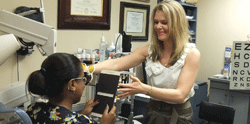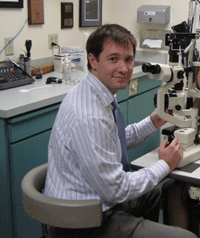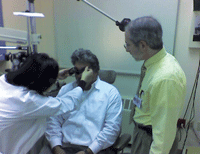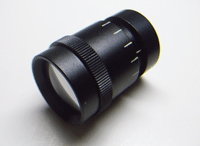Every eye doctor should be equipped with the basic items and knowledge to help a low vision patient in need in the office. Here is a list of simple tips, tools and techniques you can put into practice right away.
Diagnostic Items for Doctors
• Trial lens frame and lenses. “Giving someone a high add that is only trialed in the phoropter is a big risk. You would not be giving the patient a ‘real world’ feel for where they would have to hold the reading material to get it to the right focal distance,” says Kristin Protosow, O.D., a state-certified low vision specialist, at Eye Vision Associates in Ronkonkoma, N.Y. So, be sure your office has a trial lens frame set, she says.

Not every O.D. needs to be a low vision specialist, but every O.D.’s office should be equipped with the basics, such as a trial frame set, says Kristin Protosow, O.D.
“Also, trial framing the near prescription allows you to test lighting conditions, tints, magnifiers and other devices used in conjunction with the appropriate reading add, and it allows for eccentric viewing,” she says.
• Low vision acuity chart (Designs for Vision/Feinbloom chart or a Lea Numbers Low Vision chart). “It’s important to be able to get an accurate measure of acuity on a low vision patient, as it will help you determine how much magnification the patient might need. And the testing can be done at a closer distance, without the patient leaving the exam chair,” says Michael Fischer, O.D., chief of optometry service at the Northport Veterans Affairs Medical Center, in Northport, N.Y., and a consulting low vision clinician at Lighthouse International.
“Additionally, it can make the initial testing a more positive experience for low vision patients with significantly reduced acuity—they might only see the big E on your projector chart, but they will be able to read many more targets on a low vision chart,” he says.
• Mars contrast sensitivity test. “Contrast sensitivity function can be a much better predictor of visual function than high-contrast letter charts,” says Kevin Houston, O.D., a low vision expert who works in the vision rehabilitation laboratory at the Schepens Eye Research Institute at Massachusetts Eye and Ear. “I use the Mars test, which is held by hand at near and can easily be administered by a technician.”
• Minnesota reading card. “A continuous text reading card, such as the MN Read, will often pick up problems not evident with traditional single letter testing,” Dr. Houston says.
Simple Suggestions for Patients

Low vision rehabilitation involves more than providing a few low vision devices. Encourage patients to join a support group, says Kevin Houston, O.D.
• Tactile stickers. “Adding tactile stickers to appliances and devices can assist low vision patients in using their washing machine or microwave with ease by feeling the markers,” Dr. Protosow says. Touch Dots are an example of these stickers, and can be purchased online.
• Improve lighting and contrast in the home. “Good lighting that is specific to the task is important,” Dr. Protosow says. “Many people like the new LED lights on the handheld magnifiers and full-spectrum lights for reading because they are bright and give even illumination.”
Even simple, direct lighting with a gooseneck lamp will help patients with low vision, Dr. Houston says.
• Talking watches and clocks. “Even when patients really want to use their vision as much as possible, when they are tired or have a bad day, it can be too taxing. Sometimes the simplest device, like a talking watch, can really help,” Dr. Protosow says.
• Enhance contrast at the dinner table. “Different color plates, cups, placemats, etc., can provide a lot of help to a low vision patient,” Dr. Fischer says. For example, “don’t put the coffee in a brown mug—put it in a white mug so you can see the level as you pour. Have your white meat chicken with rice on a dark plate so you can see it, and put it on a white placemat so you see the edges of the plate,” he says.
• Recommend large-print devices. “Encourage patients to use large-number clocks and watches, big-button phones, large-print checks, and the like,” Dr. Fischer says.
• Join a support group, Dr. Houston says. Visit
www.macular.org/sgroups or
www.earsforeyes.info/ears/tblStateslist.php to recommend one in your area.
Prescribe Helpful Devices
Criteria for Low Vision Referral
Refer to a low vision specialist if:
• The patient complains about visual function and it is not likely to improve in the next three months.
• The patient’s best-corrected acuity is worse than 20/30 in the better eye and is not likely to improve in the next three months.
• The patient’s visual field in the better eye is 50º or less.
• The patient has any visual impairment and asks you to fill out a driver’s form, or asks you if driving is OK.
“I have traditionally asked my referring docs to refer using these criteria, while giving special attention to referring patients with mildly reduced best-corrected acuity (20/30 to 20/50),” Dr. Houston says. “These patients have the most urgent need because they are typically in the early stages of vision loss and are in danger of losing function and independence.”
He prefers that the primary care optometrist continues to do the routine exam with dilation but sends the patient to him annually for a low vision device update. “In this way, we’re working as a team, each delivering the service we are best equipped to provide,” he says.
“If you have a vision rehab clinic nearby, I suggest referring patients if they have complaints, or if their better eye has best-corrected vision less than 20/30 or has visual field constriction beyond 50º,” Dr. Houston says. (See “Criteria for Low Vision Referral,” at left.)
But if you don’t have a low vision clinic nearby—or even if you do—all optometrists should be comfortable providing “entry level” low vision rehabilitation care. This includes:
• Adds greater than +2.50. “The combination of a gooseneck lamp and a +3.50 add can solve many problems,” Dr. Houston says.
Dr. Fischer advises, “In reality, you don’t necessarily need anything special in your office to test patients with higher adds. You can use your trial lens set. Just don’t be afraid to test higher adds—that may be all some patients need. Don’t forget to calculate the proper working distance for the add you are testing and make sure the patient holds the print at that distance.”
• Handheld magnifiers. “If your patient has very reduced acuity and needs a lot of magnification, you might feel more comfortable referring to a low vision practitioner. But for patients with acuities better than 20/200, you can test hand magnifiers that are not that difficult for the patient to use and help them quite a bit,” Dr. Fischer says. “Have some magnifiers with lights—they can be a big help in restaurants and other places where the lighting is not the best.”
• Telescopes. “Again, you don’t have to do anything sophisticated to help some of your patients with low vision,” Dr. Fischer says. “A simple telescope to see signs in the supermarket or on the street can be a big help. Shoot for an acuity in the 20/40 to 20/50 range through the telescope. It won’t always be the answer, especially if the patient has poor contrast, but it might help.”
• Filters/tints. “Sunglasses in a contrast-enhancing tint, such as brown or amber, are useful as long as the patient’s green color perception is not desaturated beyond what is needed for driving,” Dr. Houston says.
Cutting-edge Technologies and Gadgets


Low vision patients don’t necessarily need sophisticated, high-tech equipment. For example, a simple telescope can be a big help to see street signs, says optometrist Michael Fischer (on right) with a low vision resident and patient.
Recent advances in technology can enhance the lives of low vision patients.
• E-readers (Kindle) and Tablets (iPad).“The Kindle and the iPad have been great tools for my patients because of their relatively large screen size and reading- and contrast-enhancing functions,” Dr. Houston says.
The iPad (as well as the latest iPhone and other Apple products) incorporates a number of accessibility features for visually impaired users, including Zoom and VoiceOver, Dr. Fischer adds.
Smartphones, on the other hand, are visually demanding and require a visual acuity of 20/20 to 20/40 to be fully operational, even with magnification tools, Dr. Houston says. “So, ask your visually-impaired patients if their vision prevents them from using or purchasing a smartphone. Handheld magnifiers are cumbersome to use with a phone or tablet and something spec-mounted, such as a loupe or high add, is typically needed,” he says.
• GPS with voice commands. “For driving and mobility, the voice-guided GPS systems have helped to improve patients’ safety. My bioptic drivers who have GPS are less dependent on their telescope for reading signs, which frees them up to concentrate more on vehicle control and braking,” Dr. Houston says.
Find a Low Vision Specialist
To find a low vision specialist in your area, contact:
• American Academy of Optometry Fellows and Diplomates in Low Vision,
www.aaopt.org/section/lv/diplomates.
• American Optometric Association Vision Rehabilitation Section. Or use the AOA’s Dr. Locator search,
www.aoa.org/x5428.xml, and choose “low vision rehabilitation” under the “Practice Emphasis” pull-down option.
Also, a retina specialist in your area is often able to give a recommendation for low vision rehabilitation.
Also, O.D.s should “become familiar with some of the accessibility features incorporated into the operating systems of PCs and Macs, as well as the options built into web browsers,” Dr. Fischer says. “Most browsers allow the user to magnify a web page simply by holding down the control key and hitting the plus key repeatedly until the page is large enough to see.”
Seek the assistance and expertise of a true low vision specialist early on, say Drs. Protosow, Fischer and Houston. Low vision specialists are often very willing to comanage with the referring optometrist, they say. (See “Find a Low Vision Specialist.”)
In short, providing low vision doesn’t have to be complicated, tedious or time consuming. Do what is best for these patients to provide them with optimal visual function in their everyday lives, and the sooner the better.

